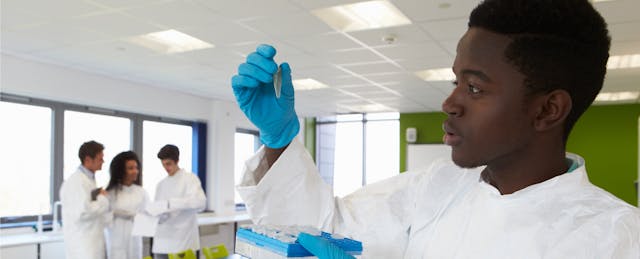Community colleges are known for innovating to meet the challenges of educating some of the nation’s most disadvantaged students: low-income, first-generation, minority, and adult learners. One new category of tool schools are experimenting with is adaptive technology. These digital tools help students master course learning goals by using data generated from students’ interactions with the adaptive software to predict what students should view or do next online. Instructors can use this data to assess what additional supports students may need on their way to fully understanding each lesson.
Established in 1963, North Carolina’s Central Piedmont Community College (CPCC) is one of the largest community colleges in the Carolinas, offering nearly 300 degree, diploma and certification programs. I spoke with biology instructor Kathy Watkins and Associate Dean of STEM Bruce Johnson about how CPCC is hoping to transform a biology survey class using adaptive technology. Watkins and Johnson highlight how adaptive tools create more enriching learning environments, improve teaching and learning, and save students money.
Manuela Ekowo: What made CPCC begin using adaptive technology?
Bruce Johnson: CPCC joined a Gates Foundation-funded Next Generation Courseware Challenge project in fall 2014, and began implementing Smart Sparrow’s BioBeyond technology in spring 2015. We hoped this tool would help us meet one of our learning goals to enhance the learning environment by increased use of innovative teaching techniques, interactive technologies, and assessment data. In addition, we also wished to increase the quality of the learning experience and student engagement with course topics while reducing costs for students and CPCC.
Tell me how the tool works.
Kathy Watkins: Within the science division, approximately 15 CPCC courses are experimenting adaptive tools. Starting in spring 2017, BioBeyond’s exploration-based course will be used as a supplement in half of our Principles of Biology sections—reaching nearly 360 students each term.
Students are assigned lessons in the adaptive course that correspond to the material being covered in the lab and/or lecture. Throughout the week, they are able to work at their own pace. This enables students to increase their exposure to the topic and work on lessons as many times as they wish until they have grasped a deeper understanding of the material.
By adopting the tool, we were able to completely integrate the lab and lecture during the class meeting times. For example, students may work on a topic more traditionally aligned with the lab in an adaptive lesson, allowing class time to be spent on components of the same topic more likely to be covered in a lecture.
This has allowed students to experience studying biology lab and lecture as a whole as opposed to approaching the course as two separate entities. In addition, since classes always meet in a lab setting, the instructor has more flexibility to create learning activities not normally available in a traditional classroom or that feature a combination of lab, group, and lecture components.
And as faculty become more comfortable with the software, we are finding that more students are completing lessons.
Are you using adaptive tools in other courses?
Johnson: We use McGraw-Hill Education’s ALEKS in a precalculus course, Pearson’s MyLab Math in a developmental math course, and EdReady—a personalized platform that assess students’ math readiness. EdReady, which is free to current and future students, allows them to prepare for the math on various placement tests without worrying about their ability to pay.
What is one of the biggest successes you’ve had using adaptive technology?
Watkins: One benefit is that we have been able to provide immediate cost savings for students, decreasing students’ lab kit costs. They were previously spending over $60 for their lab books. Now, students now only pay $25 per semester. We also replaced the $150 textbook we were using with open education resources (OER). Replacing these two books helped students save in total close to $200.
What about challenges?
Watkins: A challenge has been to ensure that all students have the technical tools to successfully use the adaptive technology. Students complete most of the work in BioBeyond outside of class time, and many rely on their personal devices. We’ve had issues with some students not being able to access all of the lessons.
As a community college, we serve a population of students that often face challenges accessing technological resources. Throughout our adaptive technology pilot, we have remained sensitive to these issues and put practices in place to support our students. For example, we use required class time to allow students to work in our computer labs, and we ensure all students are aware of the location and availability of after hours labs on campus. In addition, our libraries operate a laptop loan program that allows students to “check out” computers. Finally, we also worked closely with our technology partner to enable a streamlined sign on process that allows students to access the web-based courseware through our main college learning management system.
Education Secretary Betsy DeVos recently underscored the important role community colleges play in equipping individuals with an education that pays off in the workforce and in their lives. If in the coming years more focus (and support) is given to community colleges, perhaps so too will their efforts to help students and instructors accomplish their learning and teaching goals, all while reducing the cost for students.


